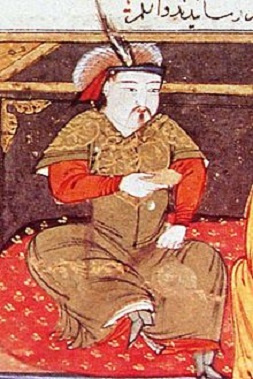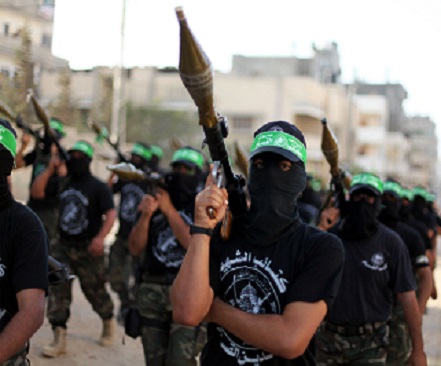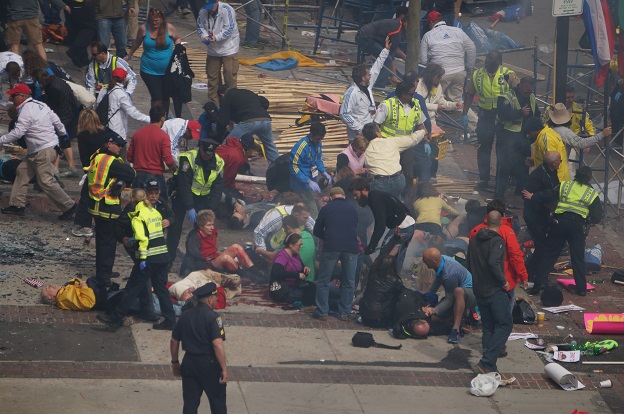Another week, another bombing. San Bernardino today, Baghdad yesterday, some other unfortunate city tomorrow. The irony is that the end result is a big fat zero. While innocent people die, the terrorists don’t really achieve anything tangible – they either die or are caught and often executed. The city limps back to normal, the terrorists go back to their bomb building basements. When and where did such madness begin?
 Terrorism is an extreme form of bullying, the word being derived from the Latin word terrere, literally “to make tremble”. The use of terror as a means of dissuasion or punishment to gain power is thousands of years old. While rulers have always employed terror to keep their subjects in check, historically it’s been the favorite weapon of the weak.
Terrorism is an extreme form of bullying, the word being derived from the Latin word terrere, literally “to make tremble”. The use of terror as a means of dissuasion or punishment to gain power is thousands of years old. While rulers have always employed terror to keep their subjects in check, historically it’s been the favorite weapon of the weak.
Terrorism targets the mind because its victims have no idea where the next blow will come from. Like in the English author Harold Pinter’s plays, terror always lurks around the corner.
According to Gerard Chaliand and Arnaud Blin in The History of Terrorism-
The fact that most notorious instances of contemporary terrorism have a religious dimension, notwithstanding their political aims, should serve to remind us that this has also been true historically of most forms of terrorism.
One of the earliest examples of religious or holy terror was the campaign of violence unleashed by the Zealots, a Jewish political movement in the 1st century CE for a period of 70 years. Known for their violent resistance against Roman rule, the Zealots had broken with Jewish society, and also with Jewish authorities and leaders.
The Zealots included a terrorist group known as the Sicarii (violent men), which assassinated both Romans and Jewish leaders with daggers. These actions were sometimes also directed towards normal citizens, and in public places. In fact, the Talmud describes the Zealots as biryonim, meaning “boorish” or “wild”; they are condemned for their aggression, their unwillingness to compromise to save the survivors of besieged Jerusalem, and their blind militarism.
The fervour of the Zealots didn’t help the Jewish cause. Zealot terrorism caused an enormous Roman backlash, leading to the destruction of the Jewish Temple. Emperor Hadrian’s army defeated the Jewish armies and Jewish independence was lost. Jerusalem was turned into a pagan city called Aelia Capitolina and the Jews were forbidden to live there. Thus began the first scattering of the Jews and the creation of the Diaspora.
Ramping up the violence
However, in the planned, systematic and long-term use of terror as a political weapon, the Nizari Ismailis or Assassins of the 13th century CE are without precedent. A Muslim sect of Shiites, they were holed up in a hundred unconquered mountain fortresses stretching from Afghanistan to Syria, the most important of which was Alamut, the Eagle’s Nest, in northern Persia. Each fortress was a “cell” and instructions regarding who to assassinate were communicated to these cells from Alamut, the headquarters.
Members followed without question the orders of their hereditary leader, the Imam. Because they believed that God chose the Imam, he was therefore infallible; he needed no education since everything he did, no matter how odd it might appear to mortals, was considered divinely inspired. His followers accepted seemingly irrational acts, frequent changes of the law, and even the reversal of the most sacred precepts as evidence of God’s plan for humanity.
Despite the lack of a conventional army, the Ismaili sect exercised tremendous political power through a highly sophisticated system of terror and assassination. The sect’s modus operandi was killing anyone, particularly leaders or powerful people, who opposed them in any way. They recruited young men with a devious technique: lured into the fortress of Alamut, they were given hashish and in that delirious state were taken to a beautiful palace replete with gardens and damsels. They were told by the Imam they were being shown a glimpse of paradise. And if they succeeded in their missions, after which death was inevitable, they would achieve instant entry into paradise as martyrs of Islam.
Chinese, Persian and Arabic sources relate the same account of how young men were lured by ample quantities of hashish and other earthly delights that awaited them in the special gardens of the cult’s castle sand fortresses. The steady supply of hashish kept these young men obedient and made them fearless. Supposedly, because of the importance of narcotics for the Ismailis, the people around them called them hashshashin, meaning “the hashish users”.
Over time, this name became modified into the word assassin. Like the modern terror cells, the Assassins employed a network of secret agents in the camps and cities of their enemies. Foremost among them were the Seljuk Turks and the caliphs in Baghdad (the Assassins murdered two caliphs). The irony is they made two attempts on the life of Saladin, who was fighting the Christian Crusaders. (It was under Saladin’s leadership that the Muslims finally captured Palestine.) One reason could be that Saladin was a Kurd, and therefore a moderate.
Mongols strike back
For 200 years the Assassins unleashed their terror in the Middle East, and it took a determined effort by the Mongols to stop them. In 1256 CE a mighty Mongol army led by a vengeful Hulagu Khan rolled across Persia. Hulagu, who followed a sky worshipping religion, and who was about to embrace Buddhism, was determined to stop the acts of terror in his empire and beyond.
According to Edwin Black the author of Banking on Baghdad, “He just refused to bow to Islam or to any belief system other than his own. Hulagu felt that Islam was an affront to monotheistic Mongol beliefs about an omnipotent god of nature that was present in all things.”
 Hulagu’s army was an amazing military machine. Besides soldiers, it comprised a thousand Chinese engineers. One by one, Hulagu stormed the 100 supposedly impenetrable Assassin castles, relentlessly killing the masters, soldiers, recruits and even infants in their cradles. The Imam himself was allowed to beg for mercy. It was denied and the Imam’s Mongol escorts kicked him mercilessly to his death.
Hulagu’s army was an amazing military machine. Besides soldiers, it comprised a thousand Chinese engineers. One by one, Hulagu stormed the 100 supposedly impenetrable Assassin castles, relentlessly killing the masters, soldiers, recruits and even infants in their cradles. The Imam himself was allowed to beg for mercy. It was denied and the Imam’s Mongol escorts kicked him mercilessly to his death.
Like the Zealots, who wanted to free the Jews but precipitated the destruction of Israel, the Assassin attempts to kill Mongol leaders led to Islam facing its gravest threat since its inception.
The Mongols rolled on to Baghdad and levelled the fabled city, killing at least a million inhabitants. Irrigation canals and economic infrastructure were destroyed beyond repair. The political institutions such as the caliphate that held the Muslim world together for centuries were abolished.
The horde destroyed almost every major Islamic city and wiped out entire populations. The Mongols were seemingly hell-bent on destroying all of Arabia, and they might well have succeeded, when suddenly Hulagu was called back to Mongolia to attend his uncle’s funeral.
The Mongol destruction of Baghdad was a psychological blow from which Islam never recovered. It marked the end of the Islamic Golden Age, during which the caliphates had extended their rule from Spain to western India, and which was also marked by many cultural and scientific achievements.
Irrational Acts
The Zealots and Assassins created terror and instability by striking at the powerful. In contrast, today’s terrorists strike at the man on the street because the rulers are well protected. Apart from that the aims of 21st century terrorists are not fundamentally different. The histories of the Zealots and the Assassins clearly show terrorism is not a recent development.
Invariably, any discussion on terror veers round to Islamic terrorism. Islamic terror is a major worry for governments because of its propensity to give local issues a global or pan-Islamic flavour. The converse is also true – Muslims worldwide take to the streets in protest against American intervention in Iraq and Afghanistan and Israeli actions in Palestine. Australian Muslims rioting on the streets of Sydney is as bizarre as it gets.
In contrast, Hindus in India did not go around killing Buddhists because of Buddhist violence against Hindus in Sri Lanka. On the contrary, Hindu India actively helped the Lankans eliminate the Tamil Tigers, which was the first guerrilla movement in the world to have a suicide squad. Again, during a 10-year period starting in the mid-1980s, Sikh terrorists systematically killed thousands of ordinary Hindus across Punjab and Delhi, but there was not one act of Hindu violence against Sikhs during that period. The only instance of rioting against the Sikhs was conducted by the Congress party, which is led by a Catholic Christian.
These illustrations negate the notion – widely believed – that terrorism is a direct consequence of the social, economic and political injustice rife throughout the world, reproducing on a global scale the class struggle of Marxist ideology.
This is where the stupid Marxists and leftists are – as always – wrong. Foreign interventions in Africa, South America and Asia have not produced Congolese, Venezuelan, Hindu, Korean or Vietnamese terrorists.
 On the other hand, every Muslim country that was invaded has produced international jihadis. It was Afghan terrorists who upped the ante in Kashmir. During the early 2000s, a senior officer from Delhi Police’s Special Cell – which fights terror – told this writer that home grown Kashmiri terrorists were easy to deal with. “Not only was it easy to fight them in gun battles but if we captured them, one hard slap was enough to make them cry like girls,” he said. “However, the Afghans are different. They fight on even after losing a leg or arm. And it took days of torture before they cracked.”
On the other hand, every Muslim country that was invaded has produced international jihadis. It was Afghan terrorists who upped the ante in Kashmir. During the early 2000s, a senior officer from Delhi Police’s Special Cell – which fights terror – told this writer that home grown Kashmiri terrorists were easy to deal with. “Not only was it easy to fight them in gun battles but if we captured them, one hard slap was enough to make them cry like girls,” he said. “However, the Afghans are different. They fight on even after losing a leg or arm. And it took days of torture before they cracked.”
Licence to kill
One reason why Muslims take recourse to religious terror is the belief that it is sanctioned by history, or at least because of established precedent. Take the Ottoman empire of Turkey, which raised state terror to a new level. The incredible wealth flowing in from the provinces allowed the sultan to keep hundreds of concubines apart from his four wives. When a sultan died, his many contending sons would launch horrific civil wars, which by their violence threatened the very existence of the empire. The solution: wholesale murder.
Edwin Black writes in Banking on Baghdad:
Fratricide became an institutional Ottoman tradition, endorsed by the empire’s Islamic scholars. In the 1400s, Sultan Mehmed formally wrote such killings into law: ‘For the welfare of the state, the one of my sons to whom God grants the sultanate, may lawfully put his brothers to death. A majority of the ulema (Koranic clergy) considers this permissible’.
For the mullahs it was a matter of expediency – by giving their nod to mass murder, they got the sultan off their backs. In the1980s when an Indian newspaper reviewed Salman Rushdie’s Satanic Verses, the Islamic clergy in South Asia and Iran promptly passed fatwas (death warrants) against the writer, without even bothering to read the book. For them it was a convenient way to appease Muslims rioting in European and Asian cities.
Closed to reform
While medieval Christian Europe had its Inquisitions, witch hunts and burnings at the stake – all forms of state terror – religious reforms gradually led to a clear separation of state and church, leading eventually to a situation where religion ceased to be a cause for war in Europe. Further, the Treaty of Westphalia led to the rise of the nation state.
On the other hand, reform in Arabia usually meant swinging from one extreme to the other. In the 1700s emerged the Wahhabis, religious fanatics who were part reformer, part Bedouin raider. Founded by Mohammad ibn Abd al-Wahab, its followers declared that all forms of Islam organized after 950 CE were blasphemous. This included both the Sunni and Shia establishments.
Forbidding the use of tobacco and alcohol, they demanded a simple life, from featureless dress to austere personal conduct. Like the Puritans of Europe, they despised anything that gave pleasure to people. For instance, the ornate shrines and mosques and elaborate minarets and archways that are a feature of Islamic architecture were not kosher in their view. Wahhabi mosques were austere statements in stone, or mud.
It’s notable that while the Wahhabis derided the gluttony and luxurious lifestyles of contemporary Muslim potentates in Turkey and Arabia, they never gave up the internecine violence that affected the common people and laid waste to the country. Massacres of blaspheming Muslims were common. In one instance in 1801, an army of Wahhabis attacked the Mesopotamian city of Karbala. Muslim women, children, young and old were mercilessly murdered, after the combatants were dealt with.
Forget the end, fight to the end
The guerrilla movements of the 20th century used terror as a pressure tactic to bring governments to the negotiating table. Militant Islam is different and difficult in that it has nothing to negotiate. The fight is to the end.
Satellite phone intercepts by India’s intelligence agencies during the November 2008 Mumbai terror attacks show this facet of Islamic terrorism. The 10 terrorists holding hostages in two hotels and a Jewish centre were in constant contact with their handlers in Pakistan. The handlers urge them to fight to the end, asking them to set fires everywhere to slow down the commandos. When a fatally wounded terrorist tells his handlers about his wounds, he’s instructed to start praying because the time for paradise has arrived.
In a way, the wheel has come full circle and we are back to the days of the Assassins. The Grand Imams of terror are hiding in their nests, this time protected by elected governments, collecting funds, creating charities to mask their identities, and training young men and women obsessed with, and mesmerized by, the idea of jihad.
The very openness of democracies makes them highly vulnerable. Terrorism thrives in disrupting the freedom of free societies by paradoxically taking advantage of the free movement possible in such places. Witness the rash of terror bombings in Russia since 1991 when it became a democracy whereas not even a fly could cross the borders of the Soviet Union prior to that. Similarly, under Chinese dictatorship the Muslim Uighur separatists find it impossible to attack places like Shanghai. Beijing’s heavy hand has bottled up the Uighurs in their native Xinjiang province.
But while terrorists can disrupt, they can’t displace. So far, no state has buckled before terrorism. That’s a ray of hope for the world’s free nations.
Rakesh is a globally cited defence analyst. His work has been published by the Centre for Land Warfare Studies, New Delhi; Russia Beyond, Moscow; Hindustan Times, New Delhi; Business Today, New Delhi; Financial Express, New Delhi; BusinessWorld Magazine, New Delhi; Swarajya Magazine, Bangalore; Foundation Institute for Eastern Studies, Warsaw; Research Institute for European and American Studies, Greece, among others.
As well as having contributed for a research paper for the US Air Force, he has been cited by leading organisations, including the US Army War College, Pennsylvania; US Naval PG School, California; Johns Hopkins SAIS, Washington DC; Centre for Air Power Studies, New Delhi; Carnegie Endowment for International Peace, Washington DC; Rutgers University, New Jersey; Institute of International and Strategic Relations, Paris; Institute for Strategic, Political, Security and Economic Consultancy, Berlin; Siberian Federal University, Krasnoyarsk; Institute for Defense Analyses, Virginia; International Center for Not-for-Profit Law, Washington DC; Stimson Centre, Washington DC; Foreign Policy Research Institute, Philadelphia; Center for Strategic & International Studies, Washington DC; and BBC.
His articles have been quoted extensively by national and international defence journals and in books on diplomacy, counter terrorism, warfare, and development of the global south.

